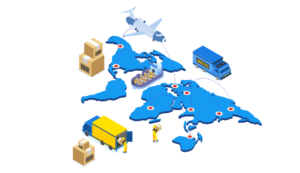Canada import management process is used by importers, customs brokers, carriers, freight forwarders and other trade participants to streamline customs processing and facilitate shipment release. Canada import management process is recommended for frequent importers and large businesses.
THE IMPORT PROCESS
Any business or individual may import goods into Canada as long as they comply with customs regulations. The import process can be straightforward or complex depending on the type and value of goods and the country of origin. Those importing low-value goods may choose to file required customs documentation on their own, while high-volume importers may engage the services of a licensed customs brokers and service providers.
If using a licensed customs broker, the CBSA requires agents to have written authorization from the importer. This can be a Power of Attorney or Agency Agreement. Non-resident importers can register with the Canada Revenue Agency (CRA) for a Goods and Services Tax (GST) number. Whether you decide to hire a customs broker or not, you (the importer of record) remains responsible for the accuracy and timeliness of the shipment information submitted to customs and other federal agencies.
Before importing products into Canada, first-time importers must obtain an import/export business number from the CRA. This can be done online or by calling the CRA. Other important considerations:
- Identify the products to be imported, and provide a detailed, accurate description of the goods. This includes the applicable HS Tariff Code and the regulations applying to the shipment.
- Determine the country of origin and the country in which the product was produced or manufactured. Many countries have tariff agreements with Canada that will reduce the duty rate.
- Prohibited goods may not be imported to Canada. You can view the complete list of prohibited items on the CBSA website.
- Find out whether the products you plan to import are restricted or subject to certain requirements such as privately-certified standards. For example, electrical appliances must be certified by a recognized certification body before they can be sold in Canada. Examples of controlled imports include steel, agricultural products, textiles, apparel, and weapons and ammunition.
- Find out if a provincial rule applies to the product. Liquor, wine and beer require prior authorization from the appropriate liquor commission before the CBSA can clear the goods.
- Goods to be imported to Canada must be properly labeled. Contact the applicable agency to ensure that the goods meet labeling requirements before leaving the country of origin. The country of origin must be clearly shown on the goods.
- Most imported goods are subject to customs duties and the GST. Duties and GST are collected at the time of import, and anti-dumping and countervailing duties are applied to certain goods sold under unfair conditions.
- Make sure to provide complete and accurate documents (invoice, bill of lading, special permits, etc.) to the customs broker and carrier to facilitate shipment clearance.
Non-Resident Importers
The Non-Resident Importing (NRI) Program facilitates the import of goods for foreign companies or individuals. The NRI program applies to companies that have no physical presence in Canada and companies that act as both the exporter from the U.S. and the importer of record using its own company name. The program was developed to help U.S. businesses access the Canadian market by relieving Canadian customers from the responsibilities of filing import documents.
TRANSPORTING THE GOODS
The importer or the seller of the goods makes arrangements with a carrier to transport the goods to the ultimate consignee in Canada. Transportation is usually arranged at the time of the sale. The seller gives the carrier the commercial invoice or Canada Customs Invoice and bill of lading when the goods are picked up at the store or warehouse.
The carrier is responsible for providing CBSA with the cargo control number (CCN), port of clearance and Estimated Time of Arrival (ETA). The carrier must also file an electronic manifest (eManifest) with the CBSA. The eManifest contains cargo, conveyance, crew, equipment and trip information. eManifest data is used by customs officials to determine admissibility, and enhance border safety and security.
The submission timeframes for eManifests depend on the mode of transport. For example, the eManifest must be received by the CBSA at least one hour before arrival at the border for goods transported by truck or highway carrier.
In addition, the carrier must also provide documentation to the customs broker or importer who will file the electronic entry. Entry information is used by the CBSA for trade monitoring and assessment of duties, taxes, and other fees associated with inbound goods. The CBSA will send a response to the broker’s submission to indicate whether the entry is accepted or rejected.
At the border, a CBSA official reviews the electronic submissions and decides whether to release the goods or refer the shipment for further inspection. Upon release, the carrier may deliver the goods to the consignee.
IMPORT MANAGEMENT PROCESS FOR IMPORTERS AND BUSINESSES
Occasional importers may choose to file the entry on their own without the help of a licensed customs broker. Carriers may also use the CBSA’s eManifest Portal. However, manual data entry is impractical for high-volume importers and large carrier that move large amounts of products across the border on a regular basis. Automation is highly recommended for these clients.
The CBSA has a list of approved vendors offering Canada import management process. Being approved means that the vendor has successfully completed systems testing with the CBSA to ensure reliable message transmission and connectivity.
CRIMSONLOGIC CANADA IMPORT MANAGEMENT SERVICE
International trade laws are constantly changing. Canada import management service from CrimsonLogic optimizes compliance and streamlines customs processing for businesses of all types and sizes. Leveraging decades of expertise in global trade facilitation, CrimsonLogic has developed advanced, industry-leading Canada import management service.
CrimsonLogic helps Canadian and foreign importers facilitate customs clearance through Canada import management service and ACI eManifest solutions. Solutions come with multiple pricing plans and connectivity options, as well as 24/7 expert assistance on customs compliance matters, a secure corporate account, advanced integration, and more.
IID/CADEX
The CrimsonLogic IID/CADEX application allows importers and brokers to send declarations to the CBSA and other agencies from any computer or device with Internet connection. Importers and brokers can exchange data with the CBSA, prepare and file B3 final accounting documents, receive release notifications, and statement of accounts.
ACI eManifest
CrimsonLogic ACI Highway, ACI Air and ACI Ocean solutions help carriers submit eManifests quickly and easily to the CBSA. Highway carriers that have enabled both ACI and ACE modules also benefit from the Conversion Tool, which creates a mirrored eManifest for the return journey.
ACI Bay Plan
Marine carriers must submit the bay or stowage plan to the CBSA 24 hours before loading the cargo at the foreign port. CrimsonLogic ACI Bay Plan automates the process for easy and quick submission.
eHBL
CrimsonLogic eHBL solution helps freight forwarders easily submit advance Electronic House Bill (eHBL) data and close messages to the CBSA within mode-specific timeframes. eHBL contains detailed secondary cargo information on consolidated shipments, while close messages link the previous Cargo Control Number (CCN) and all lower-level house bills.
RNS WACM
The CrimsonLogic RNS WACM (Release Notification System Warehouse Arrival Certification Message) application supports release status updates, shipment arrivals, Deployment 4 (D4) Notices, and Manifest Forward functionalities.
Visit our ACI page to learn more about Canada Import Management.
Related Pages
Canadian Customs Compliance Software
The ACI eManifest Portal and your ACE ACI Services Provider
ACI Highway Canada eManifest FAQ
Simplifying the Filing Process with eManifest EDI Integration
Canada eManifest: Highway Shipments Made Easy
Mandatory Electronic Notification of Cargo Arrival FAQ with CrimsonLogic
ACI for Freight Forwarders (eHBL)
ACI eManifest Phase III: Canada eManifest House Bill Data & Supplementary Cargo Reports
ACI housebill eManifest: Bill of Lading for Freight Forwarders





